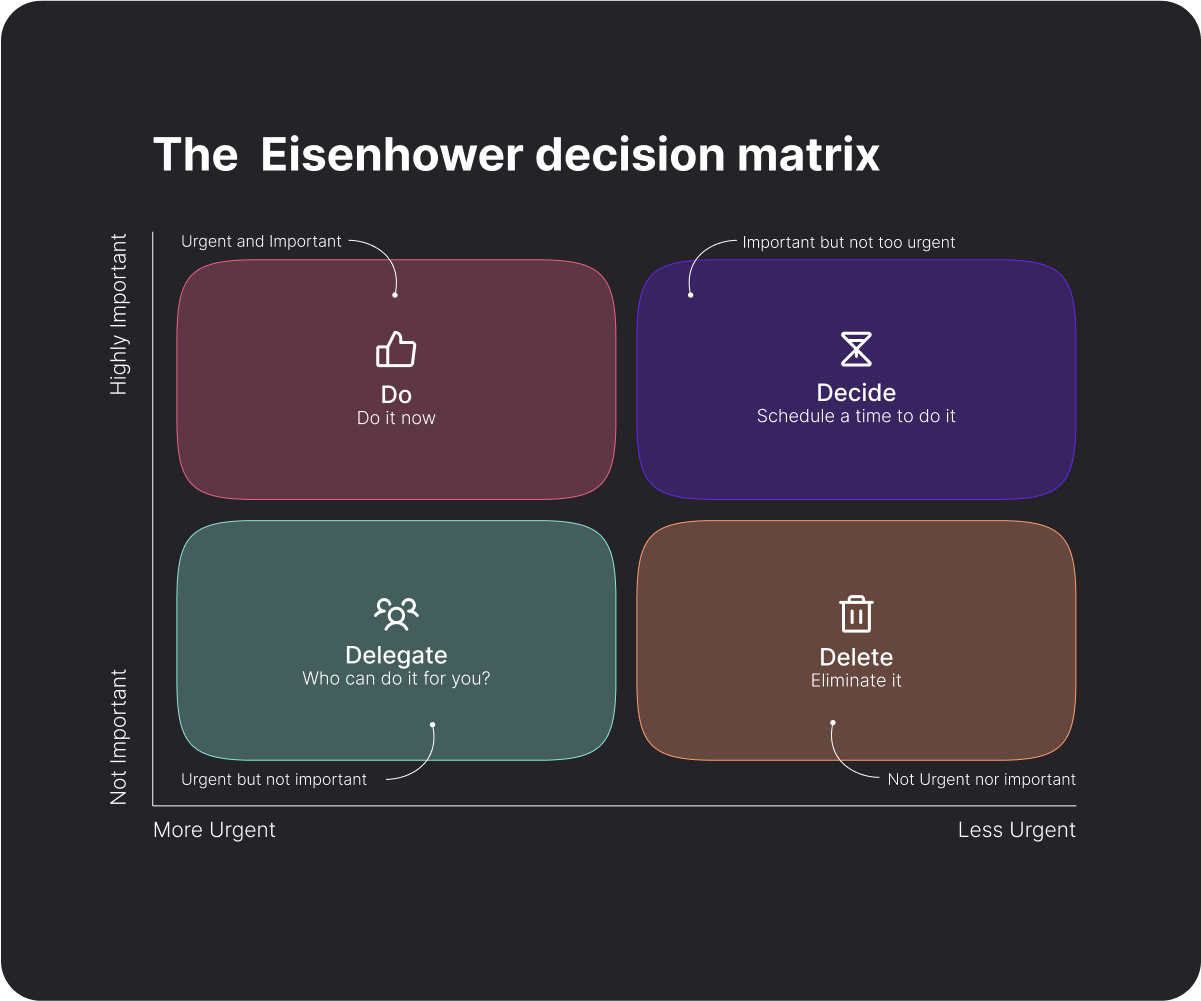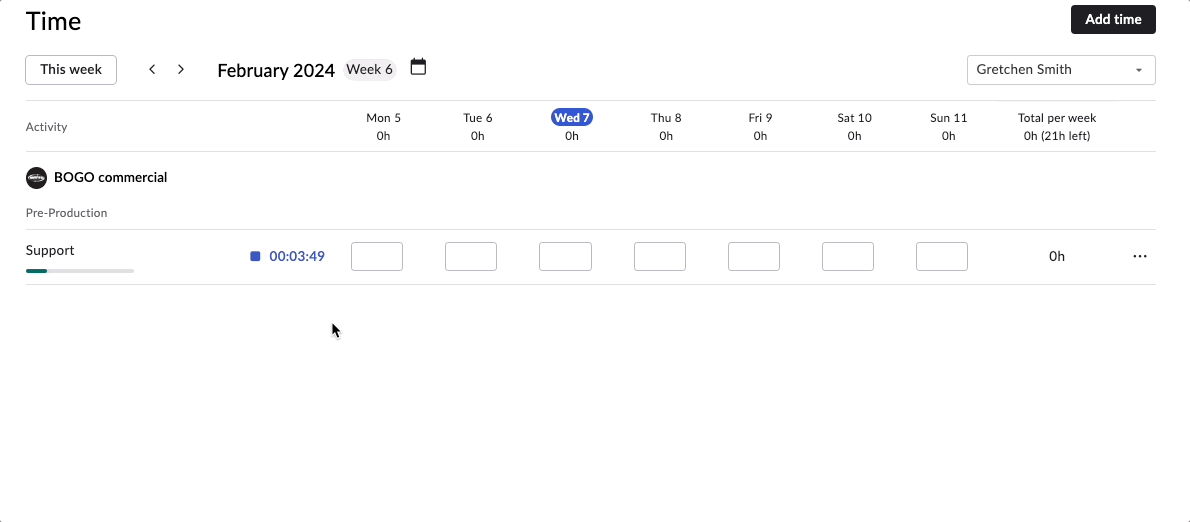How to Prioritise Tasks During Urgent Projects: 10 Strategies
Deadlines loom, emails flood in, and responsibilities pile up, leaving project teams overwhelmed and struggling to determine where to begin. The need to navigate through a sea of pressing tasks becomes even more critical during times like this.
Enter the art of prioritising tasks — a vital skill that can spell the difference between success and chaos. Mastering the ability to identify and organise urgent tasks can help you regain control over your workloads, maximise productivity, and foster a sense of accomplishment.
Understanding the urgency dilemma
Picture this. You have an overwhelming number of things to do, with tasks, demands, and managing deadlines coming from all directions, and they all seem equally urgent. You're living in a constant state of emergency where everything feels pressing and needs immediate attention.
If you’ve been there, then you’ve experienced the urgency dilemma.
The urgency dilemma is a state of perpetual urgency, where everything seems pressing and it’s tough to decide which task to focus on first. This often leaves people feeling overwhelmed and unsure of how to prioritise and manage their time effectively.
Several factors contribute to the urgency dilemma:
- Increased workload: Workloads have grown, and people often juggle multiple responsibilities simultaneously. Increasing demands can have an impact on the overall performance of team members.
- Tight deadlines: Many tasks come with tight deadlines, especially in project management, leaving little room for error or delay.
- Lack of clear priorities: Without a clear system for prioritisation, individuals may struggle to identify urgent and important tasks.
- Constant connectivity: In our hyper-connected world, we receive a continuous stream of notifications, emails, and messages demanding immediate response.
- Multi-tasking: Switching attention between different tasks seems possible, but studies have shown that just 2.5% of people can multitask effectively. To maximise productivity and maintain quality, it is often better to focus on one task at a time and avoid excessive task-switching.
Pro tip: Cut down on multi-tasking and explore our guide to improve your task management skills.
The urgency dilemma can lead to several negative consequences, including increased stress, reduced productivity, and constantly being behind schedule. It can also prevent individuals from focusing on long-term goals and strategic planning since they consistently put out fires in the short term.
Differentiating urgent vs. important tasks
Understanding the distinction between urgent and important tasks is crucial for effective time management and prioritisation. Both types of tasks demand attention, but they differ in their time sensitivity and significance in achieving broader goals.
Here's how to differentiate between urgent and important tasks:
Urgent tasks:
- Time-sensitive: Urgent tasks require immediate attention and have tight deadlines. They often cannot be delayed without consequences.
- Reactive nature: These tasks usually arise unexpectedly and demand an immediate response or action.
- Short-term focus: They are often related to immediate issues and may not contribute directly to long-term objectives.
Examples: Responding to urgent emails or messages, handling pressing client inquiries, or attending to emergencies.
Important tasks:
- Goal-oriented: Important tasks are directly linked to achieving specific objectives, priorities, or long-term goals.
- Proactive nature: These tasks contribute significantly to progress, growth, and success in the long run. They require planning and intentional effort.
- Time investment: They might have few deadlines but are significant for future outcomes and require careful consideration and dedication.
Examples: Strategic planning, professional development, and maintaining client relationships.
It is essential to strike a balance between urgent and important tasks. While urgent tasks may demand immediate attention, constantly focusing solely on them can lead to neglecting important activities that contribute to long-term success and growth. Here’s how you can manage both types effectively and strike a balance:
- Plan: Set aside time for important tasks to ensure progress toward long-term goals.
- Minimise interruptions: Reduce distractions to maintain focus on both urgent and important tasks.
- Be flexible: Unexpected urgent tasks will arise, so be prepared to adjust your schedule as needed.
- Prioritise: Evaluate tasks based on their urgency and importance. Allocate time and resources accordingly.
Related: 15 Effective Ways to Improve Team Time Management [Remote & In-Person]
Prioritise tasks with the Eisenhower Matrix
If you're having a tough time deciding what to do first on your to-do list, the Eisenhower Matrix can help you out. It's a task management technique that helps you determine which of your tasks are most urgent.
With this matrix, you can quickly see what needs to be done right away, what can be scheduled for later, what you can pass on to someone else, and what you can just forget about entirely.

The matrix is typically organised into four quadrants:
- Urgent and important: Tasks in this quadrant are urgent and significant, requiring immediate attention. They are the top priorities that need to be addressed promptly to prevent negative consequences.
- Important but not too urgent: Tasks in this quadrant are essential for long-term goals and success but do not require immediate action. These tasks should be planned and scheduled for completion to avoid becoming urgent later.
- Urgent but not important: Tasks in this quadrant are often distractions or interruptions that demand attention but do not contribute significantly to your goals. Minimising time spent on these tasks and delegating or eliminating them whenever possible is essential.
- Not urgent nor important: Tasks in this quadrant are time-wasters and should be avoided or eliminated. They have little to no impact on your goals and can be a source of procrastination if given too much attention.
Dealing with conflicting priorities
In project management, dealing with conflicting priorities is a common challenge project managers face. When various tasks, deadlines, and stakeholders' demands compete for attention and resources, it can lead to confusion and delays.
Here’s how you can deal when you’re in the middle of conflicting priorities:
- Communication is key: Ensure open and transparent communication with all stakeholders involved in the project. Discuss the conflicting priorities openly and encourage feedback from team members. Understanding everyone's perspectives can help find common ground and facilitate better decision-making.
- Reassess project scope: If the conflicting priorities are overwhelming, it may be necessary to revisit the project scope and objectives. Make sure they are well-defined and aligned with the organisation's overall goals. Avoiding scope creep whenever possible can also help mitigate conflict.
- Resource allocation: Evaluate the resources available and consider reallocating them to address the most critical priorities. This might involve adjusting timelines or bringing in additional expertise to handle pressing tasks.
- Risk management: Conduct a risk assessment to identify potential bottlenecks and roadblocks that could arise due to conflicting priorities. Develop contingency plans to address these risks promptly.
10 powerful techniques for task prioritisation
Let’s explore 10 powerful task prioritisation techniques that can revolutionise how you approach your daily responsibilities. These strategies help you gain clarity, streamline your workflow, and maximise efficiency.
1. Assessing task significance
Assessing task significance is all about figuring out how important a task is in the grand scheme of your project. It's asking yourself, "How much does this task contribute to my goals or the overall success of the project?"
Fill in the Eisenhower Matrix to gain clarity on what to prioritise. Here are some questions to also help you determine task significance if you’re feeling stuck:
- Does it align with your goals? Check if the task directly supports your personal or professional objectives.
- What are the consequences of not doing it? Consider the impact of not completing the task on time or not doing it at all.
- Does it contribute to larger projects? See if the task is part of a bigger project or has a ripple effect on other tasks.
- Who benefits from its completion? Identify the stakeholders or team members affected by the task's completion.
- Is it time-sensitive? Evaluate if the task has a specific deadline or can be done later without negative consequences.
Applying the bucket strategy
While primarily designed for personal financial planning, the retirement bucket strategy can also be adapted and applied to project management to enhance efficiency and success. In project management, the bucket strategy involves dividing tasks and resources into categories based on urgency, priority, and timeline.
Here's how the retirement bucket strategy can be applied to project management:
- Short-term bucket: In project management, the short-term bucket corresponds to high-priority tasks that require immediate attention. These tasks are crucial for keeping the project on track and meeting short-term milestones. Project managers should focus on completing these tasks promptly to address immediate project needs.
- Intermediate bucket: The intermediate bucket includes tasks that are significant for the project's progress but are not as time-sensitive as those in the short-term bucket. These tasks are planned and scheduled for completion in the near future. Project managers allocate resources and time to handle these tasks effectively, ensuring they do not become urgent later.
- Long-term bucket: The long-term bucket contains tasks that contribute to the project's overall success and future goals. These tasks may not have immediate deadlines, but they are crucial for the project's sustainability and long-term outcomes. Project managers develop strategies and allocate resources to address these tasks, planning for their completion at appropriate stages of the project.
By employing the bucket strategy in project management, project managers can better prioritize tasks, allocate resources efficiently, and stay focused on short-term and long-term project objectives. The strategy helps ensure the project stays on course, critical milestones are met, and potential risks are minimized.
Additionally, just as the retirement bucket strategy promotes diversification in financial investments, project managers can diversify their resources and team members across the different task buckets.
2. Creating a task priority list
Creating helps you stay organised, focused, and on top of your responsibilities. Here's how to create a priority list:
- List all tasks: Write down all the tasks you need to accomplish.
- Assess task significance: Determine the importance of each task by considering its impact on your project goals, deadlines, and overall success.
- Break down complex tasks: Consider breaking them into smaller, manageable sub-tasks if you have large or complicated tasks.
- Consider urgency: Identify tasks with time-sensitive deadlines or those that require immediate attention.
- Rank tasks: Order your tasks based on their significance and urgency. The most critical tasks should come first on your list.
- Be realistic: Set achievable goals for the day or week, ensuring your list is doable and not overwhelming.
- Reevaluate regularly: As new tasks arise or circumstances change, update your priority list accordingly.
- Stay flexible: Be open to adjusting your list as needed and adapt to unexpected changes in priorities.
- Focus on completion: Concentrate on completing tasks one by one, crossing them off your list as you go.

Ivy Lee Method
Make prioritisation part of your daily routine by applying the Ivy Lee Method — a popular time management and productivity technique that dates back to the early 1900s. It was developed by Ivy Lee, a productivity consultant, and is known for its simplicity and effectiveness.
The Ivy Lee Method consists of the following steps:
- Before you finish work for the day, list the six most important tasks you want to accomplish the next day. Limiting the list to six tasks helps you focus on the most crucial priorities.
- Arrange the tasks in order of their significance, with the most critical task at the top of the list.
- When you begin your workday, concentrate solely on the first task on your list. Avoid moving on to the next task until the current one is completed.
- At the end of each day, create a new list of six tasks, prioritise them, and follow the same routine the next day.
3. Applying the 80/20 rule
Applying the 80/20 rule — also known as the Pareto Principle — is a powerful task prioritisation and time management technique. The rule suggests that approximately 80% of the results come from 20% of the efforts. In the context of tasks, a small portion of your activities will have the most significant impact.
Here's how to apply it:
- Identify high-impact tasks: Analyze your to-do list and identify the tasks most significantly impact your goals or project outcomes.
- Focus on key activities: Prioritize the high-impact tasks and dedicate more time and effort to completing them. By focusing on these critical activities, you maximise productivity and results.
- Eliminate or delegate low-impact tasks: Review the remaining 80% and determine if some are low-impact or not essential to your goals. Consider eliminating or delegating these tasks to free up time for high-impact activities.
- Reevaluate regularly: The importance of tasks may change over time, so periodically reassess your priorities and adjust your focus accordingly.
4. Collaboration and delegation
Remember, you don't have to go solo. Collaboration and delegation are crucial in effectively prioritising tasks, especially in team settings.

By pooling your team’s skills, knowledge, and time, you can divide your workload more strategically. By splitting tasks based on individual expertise and availability, teams can work on multiple priorities simultaneously — getting more done in the process.
5. Consider the long-term impact
By incorporating long-term thinking into your task planning, you can make well-informed decisions that lead to sustainable success and meaningful progress toward overall company goals. The key is to strike a balance between immediate project needs and future aspirations.
If you are unaware of the company’s long-term vision, consider asking for one or building a strategic plan with the help of senior management. Strategic planning is an important part of identifying long-term goals and creating a roadmap to attain them. This makes for better progress tracking and helps your team consider the long-term impact of projects and tasks.
6. Minimise distractions and interruptions
A typical workday in the office knows numerous distractions, such as meetings, frequent task-switching, and small talk. As a result, time seems to slip away, and you find yourself lagging on tasks with impending deadlines.
If you find yourself feeling overwhelmed and in a state where nothing seems to get done, here are some tips to help you regain focus:
- Establish clear boundaries: Communicate your work hours and boundaries with your team to minimise interruptions during critical work times.
- Time blocking: Allocate specific time blocks for different tasks, allowing you to concentrate on one task and reduce distractions. Use our guide to apply time blocking to your task-filled day.
- Batch similar tasks: Group similar jobs in batches to maintain focus and minimise context switching by tackling them all at one time.
- Use productivity or time tracking software: Time tracking software can help you gain insights into productivity and make the most out of your day.
7. Timeboxing
Time boxing is about creating a firm self-imposed deadline for a specific task to encourage efficient work completion. This technique benefits individuals who struggle with perfectionism or often get caught up in small details instead of progressing to the next task.
Tracking hours and progress manually can be tedious, especially when juggling multiple projects at once. Luckily, time management software tools can help out, making time-tracking a breeze by automating the process and handling hours across various projects effortlessly.
With Rodeo Drive, you have two convenient options to track your time: team members can start a timer as they work or log their hours on a timecard after completing tasks. This way, you save precious time and effort while ensuring accurate timesheets.

8. The Two-Minute Rule
Applying The Two-Minute Rule when prioritising tasks can help you efficiently manage your to-do list and avoid small tasks from piling up.
The rule is simple: If a task can be completed within two minutes or less, do it immediately instead of postponing it. Here’s how you incorporate the time management method:
- As you review your to-do list or incoming tasks, quickly identify those that can be completed in two minutes or less. These are typically small, straightforward tasks that require little time or effort.
- Once you spot a task that fits the criteria, take immediate action and complete it right away. Avoid the temptation to put it off for later.
- While The Two-Minute Rule is beneficial for handling small tasks, ensure it doesn't interfere with your focus on more significant, time-consuming priorities.
- Remember that the rule is a guideline, not a strict limitation. If a task takes a bit longer than two minutes but is still relatively quick, use your judgment to decide whether to complete it right away or defer it.
9. Implement a task deadline system
Effective task deadlines help you stay on track, meet objectives, and progress toward your goals.
Start by dividing larger tasks or projects into smaller, manageable sub-tasks. Assign deadlines to each sub-task to track progress effectively.
Then, determine the order of importance for each task. Consider urgency, impact on other tasks, and overall project deadlines. Set achievable deadlines considering the complexity, available resources, and team capabilities.
Keep track of deadlines in a centralised system or a project management tool. This ensures that everyone has access to the latest deadlines and updates, and if a deadline is missed, analyse the reasons for the delay and take corrective actions to prevent a recurrence.

Regularly review the effectiveness of your task deadline system. Gather feedback from team members and make improvements as needed.
10. Review and adapt
Reviewing and adapting your task prioritisation process is crucial to stay effective, focused, and aligned with your goals.
Set aside time at regular intervals — weekly, monthly, or quarterly — to review your task prioritisation system. Use this time to assess your progress, identify bottlenecks, and determine if tasks are being completed as planned.
Circumstances may change, and specific task priorities might need to be adjusted. Reassessing your process should involve evaluating the outcomes of completed tasks and determining if the prioritisation decisions led your team to meet deadlines.
Seek feedback from team members and stakeholders involved in the tasks as well. Understand their perspectives on the prioritisation process and identify areas for improvement.
Overall, you’ll want to apply this knowledge to refine your approach and future decision-making. Ensure that any adjustments to task prioritisation are communicated clearly to team members and stakeholders.
Common challenges with task prioritisation
Task prioritisation comes with its fair share of challenges. Here are some common challenges and how to overcome them:
Scope creep or changes
Expanding the scope of the project and its tasks without considering the impact on existing priorities can lead to inefficiency and delays.
How to solve this:
Clearly defining and documenting your project scope and effectively communicating that vision to stakeholders significantly minimise scope creep. Use your project plan to outline the process for establishing and managing the project's scope throughout the entire project’s lifecycle.

Task dependencies
Tasks depending on other tasks or team members can delay prioritisation decisions and impact overall progress.
How to solve this:
Identify the most critical dependencies that can significantly impact the project's progress. Focus on addressing these first to mitigate the risk of major delays. Encourage collaboration among team members and those involved in dependent tasks. Facilitate coordination to ensure seamless handoffs between tasks.
Lack of time awareness
Underestimating the time required to complete tasks can lead to unrealistic prioritisation and missed deadlines.
How to solve this:
Start by tracking time spent on different tasks and projects. Use time tracking tools or apps to gain insights into how you and your team allocate time and be realistic.
Decision paralysis
Decision paralysis occurs when faced with too many choices or options, making it challenging to decide. When it comes to task prioritisation, decision paralysis can manifest in missed deadlines.
How to solve this:
Consult with other project managers and mentors who can offer valuable insights and fresh perspectives. Use these insights to imagine the potential outcomes of each choice. Visualising the results can make the decision more real and help you gain clarity.
Once you decide and set a deadline for the task, commit to it and move forward. Avoid second-guessing yourself, as it can lead to further indecision.
Avoiding burnout with a project planning tool
Too many things to do with so little time might make you reactive instead of proactive.
Rodeo Drive helps you assign tasks and track their time and simplifies workload management and capacity planning with its planner feature.
By glancing at your planner, you can instantly view the tasks assigned to each team member throughout the week, making it a breeze to handle multiple projects simultaneously.
Powerful insights
Rodeo Drive’s features are interconnected, leading to the automatic generation of project reports that provide valuable insights for decision-making.
.png)
You'll have access to reporting data on project financials, time registration, and employee productivity. You can also filter this data by project status, client, team member, or time period. Want to create your own reports outside of the platform? No worries. You can export this information as an Excel or CSV file.
Rodeo Drive’s other key features
Rodeo Drive offers a range of powerful features designed to streamline your complete project management process:
- Invoicing: Send customized invoices directly to clients from the platform based on project phase, estimates, or actuals. Invoices can be sent via QuickBooks in the US.
- QuickBooks (US) and Xero (UK) Integration: Integrate seamlessly with QuickBooks (US) or Xero (UK) to simplify your bookkeeping and billing process.
- Multilanguage: Easily switch between Dutch or English languages in Rodeo Drive by selecting your preferred language.
It’s easy! Give it a shot for yourself and try for free today.








